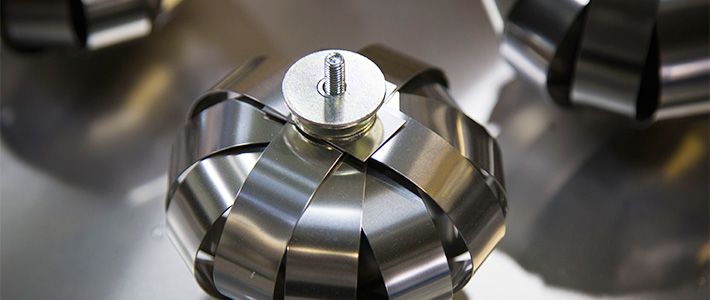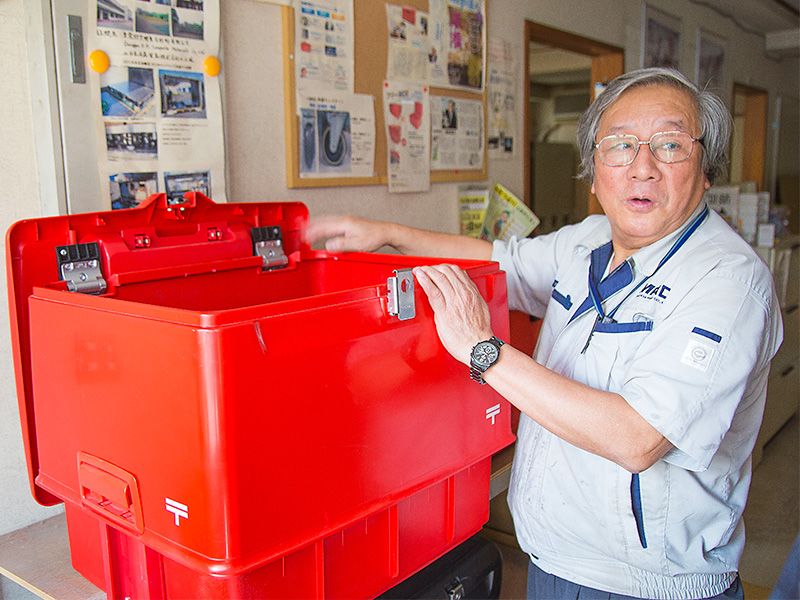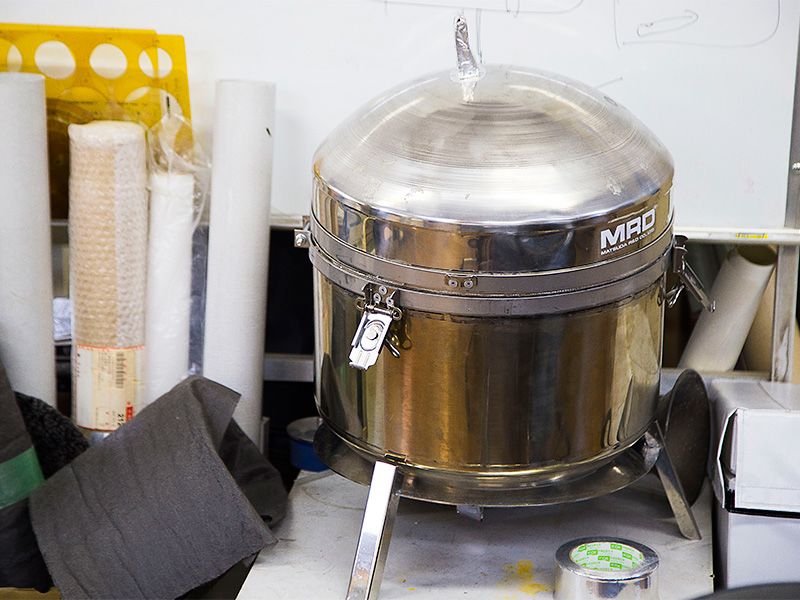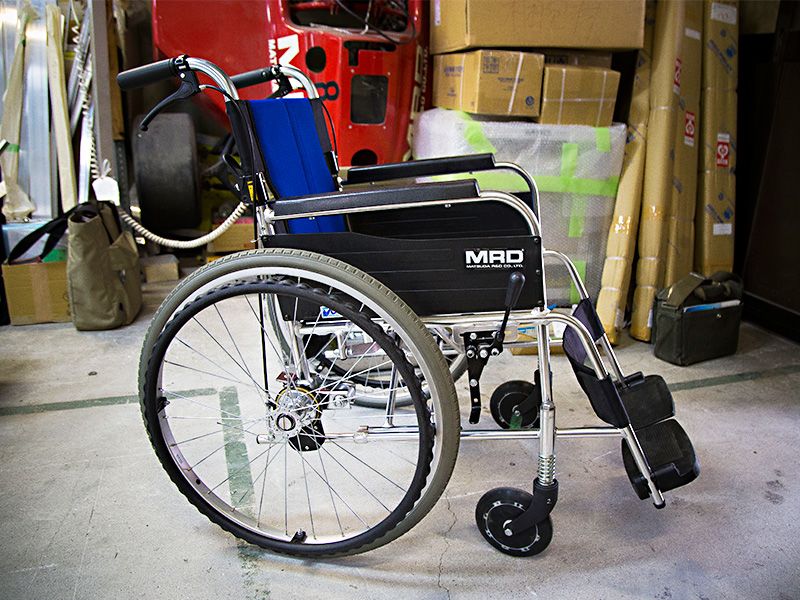
Original Vibration Control Leads to a Series of World Firsts
Economy- English
- 日本語
- 简体字
- 繁體字
- Français
- Español
- العربية
- Русский
Postal Delivery Box Becomes First Hit
When he quit his job at Honda in 1982 at the age of 37, Matsuda Shinji was a star motorcycle parts designer. Speaking of the move, Matsuda says that motorcycle parts are in a sense just a type of luxury good. “I wanted to do something that would contribute more to society.”
In 1996 Matsuda was asked by the Ministry of Posts and Telecommunications (today the Ministry of Internal Affairs and Communications) to develop carrier boxes for mail delivery motorbikes. The order was a difficult one, he says, as they wanted a “box that would become bigger when loaded with lots of mail and smaller when there was not much mail; one that would not have a cover during delivery but could be covered if it started to rain; and one that would not break even if the motorbike overturned.”
Matsuda came up with the idea of a two-layered structure for the box. The outer side of the box could be pulled up when there was a lot of mail and lowered when there was less. A slide system was used to open and close the cover. It could normally be left open, but closed when it started to rain. The box was met with great approval by postal workers and Matsuda R&D delivered a total of 110,000 boxes to post offices nationwide. Today, 20 years, about 60,000 are still in use.
 The hit postal delivery carrier box
The hit postal delivery carrier box
A Space-Age Sample Collection Box
Matsuda fields exotic orders all the time. In December 2000 he was approached by camera giant Canon with a request to transport a telescope that was to be installed in an astronomical observatory in Hawaii. The device MRD developed for this was an air suspension system using tire inner tubes.
The Japan Aerospace Exploration Agency later caught wind of this and asked MRD to develop a collection box that could safely carry a capsule to Japan after the asteroid explorer Hayabusa returned to earth. JAXA wanted something that would reduce the g-force impact on the container, keeping it under 1.5 g during transport, and could be transported by airplane to Japan after being carried by off-road vehicle from the Australian desert where the capsule would land. The impact of jolts in normal truck transport is 10 g, and even with a fully functional air suspension is still 5 g. Achieving vibration of less than 1.5 g was thus a very tall order.
The idea that came to Matsuda was the “metal sphere suspension,” in which eight strips of stainless steel are combined to make a sphere. Today this is one of MRD’s major vibration control technologies.
“After trying many things I hit upon the idea for this shape when I was looking at a tennis ball. With a sphere, vibrations are dissipated in all directions,” says Matsuda.
Through a process of repeated design revisions and improvements, the system was developed to the point where it absorbed 98.5% of vibrations. Hayabusa touched down safely in June 2010, and the samples it was carrying arrived in Japan without incident.
Next Up, a Vibration Damping Wheelchair
The vibration damping technology used for Hayabusa was next applied to wheelchairs. Many wheelchair users are troubled by the small vibrations that are transmitted from gradations and other unevenness in road and sidewalk surfaces. And while it is true that wheelchairs equipped with suspension systems are available, the price is daunting, at ¥200,000 and up for models in Japan.
MRD began working to develop a vibration damping kit with which a suspension mechanism could be installed at the front casters and rear drive wheels of people’s current chairs, eliminating the need to buy a whole new wheelchair. Users will be able to choose where they want to install the vibration-damping devices, for example at the casters only or the drive wheels only. Maintenance will also be simple, and the price has been kept low.
“We are finally coming to a stage where we can mass-produce these kits in 2015,” says Matsuda.
Heat-Insulated Human Organ Transport
Recently the company’s efforts have been focused on the development of vacuum insulation panels with a thickness of about 20 mm. In these panels two sheets of stainless steel are bonded together. Glass pins about 6 mm in diameter are set between the sheets every 200 mm to minimize the places where heat can escape. A vacuum in the space between the two sheets produces outstanding thermal insulating properties.
Compared with urethane foam, an insulating material in widespread use, the thermal insulation property of these panels is about 50 times greater. Since the material is thin and durable—it can last for about 50 years—it has potential uses as a covering for refrigerated containers, constant-temperature transport cases, and other containers.
Using its insulation panel know-how, MRD has started developing a 40-liter cylindrical super-heat-insulated container. The flat heat insulation panels are circular and the glass pins are eliminated. These containers have been used to carry human organs for transplant, iPS cells used in regenerative medicine, and other materials. Whereas existing insulated containers can maintain temperature for a single day, these new containers can maintain temperatures for four days.
 Super heat insulation container
Super heat insulation container
This product attracted attention from a Chinese medical association, leading to the establishment of the Wuhan MRD Research Center in Wuhan City’s East Lake High-Tech Zone. In addition to super-heat-insulation containers, the center is working on vibration-damping pallets and wheelchairs.
“Technology is global, and so whether the work is done in Japan or China, it’s fine with me,” says Matsuda.
MRD has adopted a business model in which the company is not involved in production but rather sells the technology it has developed to manufacturers and receives royalties and development contract fees. Nor does the company president himself conduct sales. The company sells some products on its own, but its assembly and mass production are outsourced. Whatever its business format, though, Matsuda R&D seems well-placed to remain at the forefront of nimble innovation.
(Originally written in Japanese by Nagasawa Takaaki; photos by Ōtani Kiyohide. Banner photo: The metal sphere suspension at the heart of Matsuda R&D’s vibration control technology.)Corporate Data
Matsuda R&D Co., Ltd.
Head office: 27-6 Miyamoto-chō, Itabashi, Tokyo, 174-0054 Japan
Representative: Matsuda Shinji
Business: Development and sales of vibration-damping suspension (air suspension, metal ball suspension); development and sales of air cargo containers, vacuum insulation panels, etc.
Capital: ¥25 million
Employees: 10
Website: http://www.mrd-matsuda.co.jp/
research and development asteroid explorer Hayabusa Vibration control technology Matsuda R&D Co. Honda Motor Co. organ transplantation insulation technology
